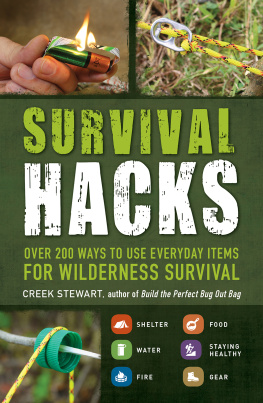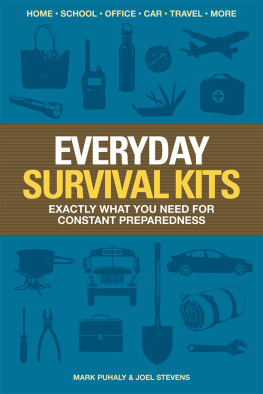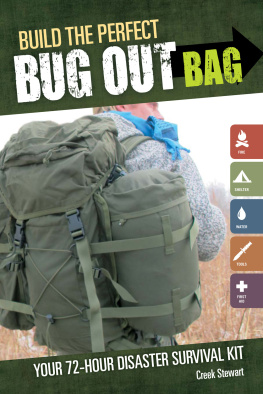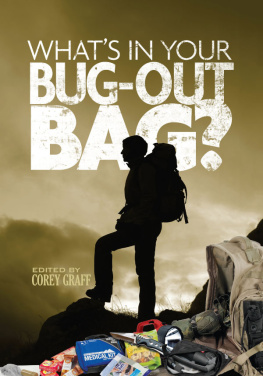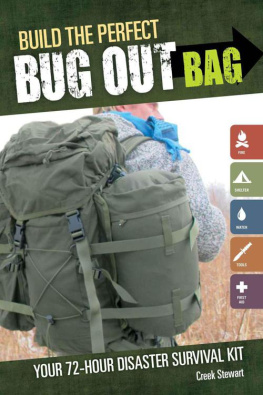Contents
Guide
SURVIVAL
HACKS
OVER 200 WAYS TO USE EVERYDAY ITEMS
FOR WILDERNESS SURVIVAL
CREEK STEWART, author of Build the Perfect Bug Out Bag

AVON, MASSACHUSETTS
Contents
CHAPTER 1
Shelter Hacks
CHAPTER 2
Water Hacks
CHAPTER 3
Fire Hacks
CHAPTER 4
Food Hacks
CHAPTER 5
Staying Healthy
CHAPTER 6
Gear Hacks
CHAPTER 7
Forward Movement
CHAPTER 8
Everyday Carry (EDC) Kits on a Budget
Introduction
sur-VIV-al HACK-ing
verb
The act of using what you have to get what you need to stay alive in any situation.
Hacking is making do with what youve got. It has three aspects:
- Using knowledge of basic survival principles
- Innovative thinking
- Exploiting available resources
KNOWLEDGE OF BASIC SURVIVAL PRINCIPLES
Knowledge is the basis for almost every successful survival skill. You can get it from reading books, listening to the advice and stories of others, and watching the actions of others. However, the most important way to gain true knowledge of survival principles is trial and error with your own two hands. No method of learning takes the place of hands-on, personal experience. Your options in a survival scenario will ultimately depend on your understanding of basic survival principles that surround shelter, water, fire, and food.
INNOVATIVE THINKING
Ive often said that innovation is the most important survival skill. Innovation can be defined in survival as creatively using available resources to execute a plan formulated using pre-existing survival knowledge. At the end of the day, the application of survival principles is only limited by your ability to creatively use them.
EXPLOITING AVAILABLE RESOURCES
Available resources are anything natural or manmade, from leaves and sticks to trash bottles and windshield wipers. Everything is potentially a survival resource that you can exploit, with knowledge and creativity, to get what you need. In this book, we explore hundreds of everyday items that can be modified, repurposed, reused, reshaped, rebuilt, or recycled to meet some kind of basic human survival need.
THREE THOUSAND FAILURES
Some of the hacks featured in this book are tips and tricks Ive absorbed throughout my lifelong study of survival; I learned them from other people and from watching others in the field. Ive picked up all sorts of hacks from friends, family, students, and other survival enthusiasts. Im always on the lookout for a fun, new, and creative survival hack.
However, many of the following 200-plus survival hacks are also the result of more than 3,000 failed attempts. Some, such as the in Chapter 3, took more than 20 tries to get right. If I had quit working on a hack idea at the first failed attempt, this book would be about five pages long.
The 200-plus hacks listed in the following pages are proven to work. Ive successfully practiced them all. Each of them is an actionable lesson in survival; you can go into your backyard and practice them right now. Many can be executed in the comfort of your home or garage, and certainly you can use them on your next camping trip.
THE MORE YOU HACK
As you study, practice, and use these 200-plus hacks from everyday objects, youre bound to learn more about survival principles and how to creatively meet basic survival needs. This knowledge will lead to new hack ideas that I want to hear about! E-mail your hack ideas to . Who knows, your hack could make it into the next volume of Survival Hacks.
Chapter 1
Shelter Hacks
In extreme conditions, you can survive as few as 3 hours without shelter. Exposure to the elements is almost always your number one survival priority. Keeping warm, cool, dry, or protected from the rain, snow, and wind is easier said than done when youre working with limited resources. You may need some creative hacking in order to be effective.
Ill never forget the words of a wise Scoutmaster when I was a kid: Boys, the ability to dress yourselves is the first of all great survival lessons. He was right. Shelter starts with clothing and footwear. It ends with more complicated principles such as windbreaks, insulation, bedding, roofing materials, fire reflection, and waterproofing.
This chapters hacks are all designed to help offer protection for you and your gear from your biggest survival adversarythe weather. Without protection from the elements, few other survival priorities matter. The ability to cope with what the weather throws at you is what keeps you alive long enough in order to even execute other survival skills directed toward water, fire, or food. Well start this chapter of shelter hacks in the spirit of my old Scoutmasterwith clothing.
CLOTHING HACKS
A BELT WITH TRACTION
A broken belt in the field can be a devastating setback, especially if youre using your belt to carry gear such as a knife, your everyday carry (EDC) kit, and saw. A surprisingly simple and very durable hack belt can be made from the tread of an old bicycle tire. When the walls are trimmed away until just the face tread remains, it becomes the perfect belt width. Staple, rivet, or lash one end to your buckle, punch holes in the other end for adjusting, and youve got a belt that will last a lifetime. You can also use bicycle tire treads as suspenders, pack straps, replacement handles, and rifle slings. Slivers from the rubber tread can even be used as harsh-weather fire starters.

PANTYHOSE PREVENTION
An old hunting buddy introduced me to this unique hack, and Ive never forgotten it. As manly as he was, he wore pantyhose every time he huntedboth in summer and winter. During hot summer months, he swore that the pantyhose barrier made it impossible for ticks to latch onto the skin. In cold temps, pantyhose make a very effective base layer. Its all about layering in cold weather, and the addition of a few pairs of pantyhose to your cold-weather car kit is a great idea thats easy on the wallet. If youre using a new pair of boots, pantyhose can also help prevent blisters by reducing the friction from your shoe. Simply trim off the feet and wear them as a sock liner.
LIP BALM ZIPPER WATERPROOFER
In extreme weather, even the slightest nonwaterproofed area or seam can become a huge setback and source of frustration. Many zippers are water repellent because of their construction, but they are not waterproof. One way to help waterproof jacket and backpack zippers is to run lip balm with firm pressure along the length of the zipper. Wax from the lip balm will press into the cracks and prevent water from seeping in. This will also help to lubricate the zippers (especially metal ones) and make them easier to use. Other products that can work for this in a pinch are crayons, candles, some hair pomades, and beeswax. The wax will wear off with use, but is a great temporary fix when Mother Nature proves to be unmerciful.
HANDY TOOL/GEAR GRIPS
Places and ways to secure gear and tools should be a part of every survival wardrobe. Here is a quick hack using bicycle inner tubes to secure a variety of tools and gear to belts, backpack straps, knife sheaths, and even walking sticks. Crosscut sections of bicycle inner tubes are widely known within the survival community as Ranger bands. When these sections of inner tubes are threaded onto belts or backpack shoulder straps, they make secure grips for a variety of small gear that you wish to quickly access. I keep a multitool right on my backpack strap, using Ranger band gear grips to hold it securely in place. These grips are weatherproof, inexpensive, and very strong. They can also be used as an effective fire tinder in bad weather.

